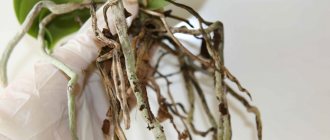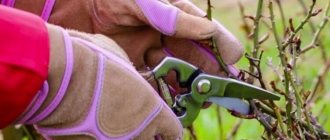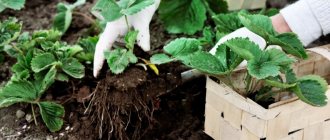Features of the structure and functioning of the orchid root system
To make the right decision about the need to prune roots, it is important to know about their structure and operation. The root system of most orchids is radically different from the underground organs of other plants.
Its characteristic features:
- Regular cylindrical shape in cross section.
- The covering spongy tissue is velamen . It absorbs oxygen and nutrients from the air.
- Change in root color , which indicates the need for moisture. If the roots are bright green, there is enough water and nutrients. When a whitish coating appears, this is a signal of a lack of moisture.
- The bulk of the roots grow in a special substrate and need good aeration and lighting. Therefore, orchids are planted in flower pots made of transparent plastic.
- Aerial roots are located above the substrate, under the base of the rosette of leaves. Thanks to them, the absorbent area of the root system increases, which receives moisture from the surrounding air.
Important! Some novice orchid lovers mistake aerial roots for an abnormal phenomenon or disease. That's why they cut them off. This is categorically wrong. Such roots should not be touched; they are very important for the normal growth of the orchid. The only exceptions are dry or diseased shoots.
The appearance of the roots can indicate the health of the plant.
When not to do this
There are some contraindications for pruning. For example, you cannot cut off the roots when the orchid is in the flowering stage. Although this procedure is intended to improve health, it is stressful for the plant. Moreover, in addition to removing unnecessary processes, it is combined with a forced transplant.
If you do this during flowering, then in most cases it will end immediately. The flower will shed both buds and flowers.
Otherwise, you can choose any time, since the presence of damaged roots can provoke the development of any diseases.
When and how to prune aerial roots
It does not matter how many aerial roots the orchid has formed, several pieces or a whole bunch. Trim them if they are shriveled or diseased.
Tip #1 : Pay attention! If an orchid does not develop young aerial roots for a long time, it means the plant does not have enough moisture. When they grow too actively, watering and spraying should be limited.
The roots may partially dry out. Then they are trimmed down to living tissue. When the roots dry out completely, they are cut to the ground.
This is also done if suspicious dots, spots, or islands appear on the roots. Most likely, the orchid is sick, and the affected organs need to be removed so that the infection does not spread to healthy tissue.
To do this you need:
| Prepare tools | Wipe the blade of a knife or pruning shears with a disinfectant. For example, alcohol. This is necessary in order not to spread the infection. |
| Trim dry or diseased roots | The cut is made down to living tissue, at a distance of three centimeters from the site of the lesion. Pruning is done carefully, but thoroughly. If even the slightest bit of dead or diseased tissue remains on the cut roots, it will further destroy healthy organs. |
| Dry the sections | After pruning, copious drops of sap appear at the edges. You need to wait until they dry. |
| Handle | Sprinkle the sections with one of the following disinfectants: |
Activated carbon ( crushed),
· Wood ash , crushed into powder,
· Ground cinnamon.
After the pruning procedure is completed, the orchid cannot be watered or sprayed for several days. Otherwise, there is a high probability of recurrence of the disease.
Which roots need to be removed?
Through the transparent walls you can clearly see how the orchid’s root system feels. If the roots are intact, elastic, and have a characteristic color, then the plant is in good health. But when they dry out, rot or become stained, something is wrong with them. Read more about why roots deteriorate and in what cases they can be saved by pruning.
Lack of light and heat
Pathogenic microorganisms are always present in the substrate. Under optimal growing conditions, there are few of them and they are not dangerous to plants. But, in an unfavorable environment - from a lack of light, air, heat, and when moisture stagnates, pathogens multiply at an incredible speed. In this case, the orchid's root system cannot cope with the infection.
Over time, the plant material becomes rotten, crushed, and compacted. The root system does not receive the required amount of air. You could say he's suffocating.
Water is retained in the compacted substrate. These factors lead to rotting of the roots.
Causes of rotting orchid roots
As it turned out, you can cut the roots of orchids only if they are sick. Most often they rot. The reason for this may be various factors.
Insufficient lighting
Root rotting in phalaenopsis is most often observed in winter. It is at this time that the days become shorter, and during the day there is little sun outside the window, since most often it either rains or snows. But the development process of orchids does not stop. In their homeland, these plants enjoy the bright rays of the sun throughout the year. At the same time, for the full development of orchids, a certain light is necessary, which serves as a signal for moisture absorption, when water from the velamen is “pushed” deep into the root and rises up to the leaves. If there is insufficient light, moisture will simply accumulate in the roots, waiting for a signal to rise to the top. During this waiting process, some of the water may evaporate, for example, if the roots are above the substrate and the room is well ventilated. But still, most of the moisture remains, due to which the structure of the velamen cells changes and the roots begin to rot.
Overwatering
In winter, you need to water the orchid as little as possible due to lack of lighting. Without receiving the proper amount of light, their roots simply do not drink.
Fungal diseases
A large number of fungi parasitize the roots of orchids. But while their numbers are small, they cannot cause any damage to the plant. But if the velamen is filled with water for a long time, for example, with abundant watering and poor lighting, then the population of microorganisms will increase sharply, as this will create a favorable environment for their reproduction. Moreover, for some types of soil fungi, literally 6 hours are enough to begin decomposing the roots. If the affected shoots are not removed in time, the parasites will destroy the entire root system and move to the stem and leaves of the plant.
Substrate compaction
Over time, even the highest quality substrate begins to decompose, losing its most important property - breathability. Namely, this quality is very important for the full growth and development of phalaenopsis.
When destroyed, the soil begins to become compacted, resulting in less oxygen for the plant's roots. Even good lighting will not help cope with this problem, because air helps water move from the roots to the stems. With a lack of light, this process is further aggravated, since with a small amount of oxygen, excess moisture cannot evaporate, which accelerates the process of root rotting. Algae and soil fungi can speed up the compaction process of the substrate.
Mechanical damage
When replanting an orchid, it is very easy to damage its roots. And often gardeners, in order to correct their mistake, cut off damaged shoots. But healthy, even broken sprouts should not be cut off. If you do this, then the cut area must be treated, because the damaged area does not absorb water and with prolonged contact with moisture it begins to rot. This process gradually spreads to the entire root, as a result of which it dies.
Fertilizers
Orchid roots are quite sensitive to phosphorus and potassium salts, which are contained in most fertilizers. A high content of these compounds in the substrate can burn the roots, causing them to dry out and stop absorbing moisture. As a result, the shoots begin to swell and rot.
How to trim orchid roots correctly
If you notice that the roots are dry, rotted or diseased, the orchid needs to be replanted. Before this, the root system is carefully examined, trimmed, processed and placed in a fresh substrate.
The work is done like this:
- The orchid is removed from the flower pot and cleaned of the substrate.
- The remaining soil mixture is washed under running warm water.
- The roots are dried.
- Using pre-disinfected pruning shears (or a sharp knife), cut off dry, rotten or diseased roots.
Sometimes it is not easy to distinguish healthy roots from diseased ones. Outwardly they may be similar. To determine the condition of the appendix, it must be lightly pressed. If the root is healthy, it is elastic and will not break. The infected root is soft to the touch, releases viscous mucus when pressed, and breaks easily.
“The Mystery of a Strange Disease of Orchids”, author – G. Gruzinova , magazine “Planet of Orchids”, No. 33(1), 2014.
- The sections are dried naturally by placing the roots on a clean, soft cloth.
- Treat with an antiseptic, such as activated carbon.
- Planted in a new substrate. But if the root system has been severely affected by fungal rot, then before planting it is soaked in a fungicide solution. protective equipment is used :
- Biological - “Fitosporin”, “Alirin”, “Gamair”, “Trichodermin”, “Mikosan”.
- Chemical - “Chistotsvet”, “Quadris”, “Fundazol”, “Skor”, “Ridomil Gold” “Ordan”, etc.
Tip #2 . Biofungicides are used for minor orchid infections. If the disease has gone too far, chemical remedies will be needed.
How to distinguish dead roots from living ones?
It is quite difficult to visually distinguish living shoots from dead ones. But knowing the features of the phalaenopsis root system, this can be done with the help of water. To do this, the plant must be removed from the pot and immersed in a container of water. If the roots in the water have acquired a bright green tint, then they are healthy. If their color has not changed, it means that the shoots are dead and need to be removed. Also, a disease of the shoots is indicated by a violation of the outer layer of velamen, for example, if when pressed it is easily removed, exposing the internal tissues of the root.
There is an easier way to determine the “sick” roots of an orchid. So if you lightly squeeze the shoot with your fingers and it turns out to be empty or a slimy liquid comes out of it, then it is dead.
Category: “Question – answer”
Question No. 1 . From a friend I heard about feeding orchids with sugar. I sprinkled it in the pot, waited a week, but, in my opinion, nothing good happened. Why is that?
Perhaps something went wrong. Remember whether you watered the substrate before and after fertilizing. If the crystals got into a dry environment, they did not dissolve for a long time, which means they did not have an effect. Another time, before adding sugar, water the orchid thoroughly. It is likely that the results of feeding will appear no earlier than after 2 weeks.
Reviews
Varvara Sergeevna (St. Petersburg)
As soon as the orchid has young leaves and flower stalks, I feed them with complex fertilizers every week. But, once a month, I water the orchid with glucose instead. I noticed that after this they bloom better and longer.
Orchid is an exotic flower. It has been decorating window sills in Russian homes for quite some time now, but not everyone has the patience to organize proper care for it. A few people care about lighting, temperature conditions, and watering, but their efforts will not pay off if they cut the wrong roots.
The root system is the most problematic area of a flower. She has a special structure. Not knowing how to care for her; Without knowing the secrets it conceals within itself, the orchid will not live long and will not bloom profusely. Is it necessary to cut off dry aerial roots from a plant, and how to do it correctly? You will find answers to these and other questions in our article.
Overhead and underground
Orchids have aerial and underground roots . Flower growers see both, since the orchid is grown in a transparent pot. Botanists see an invisible connection between aerial and underground roots.
The first are modifications of the second. They are located in the above-ground part of the plant. They are needed to absorb rainwater and oxygen from the air. All tropical crops (and the orchid is a guest from the tropics) have this type of root system, since there are few mineral salts in the soil layers under natural conditions.
Functions of aerial roots:
Epiphytes growing in the wild have well-developed aerial roots, with the help of which moisture is collected from the atmosphere when there is no rain in the tropics for a long time, and even in the bark of trees it is not stored.
Below is a visual video about the importance of orchid aerial roots:
Is it necessary to prune?
Beginner flower growers often wonder whether it is necessary and whether it is possible to cut off the roots. They consider above-ground shoots a sign of the development of a serious disease in their pet. Because of this, they often act imprudently, immersing them in the substrate or cutting them off.
Neither aerial nor underground roots are cut off without a serious reason .
This is what they do when they see that they have dried up, begun to rot or die. A healthy root is greenish when wet and silver-gray when dry. The younger he is, the richer his color scheme. Sometimes you notice the absence of young light green roots. In order to solve this problem, adjust the frequency of watering. If there are a lot of them, water the plant less often.
Alive
A living root is easy to distinguish from a dead one . It is white then, like a dead dark or darkened one. Unable to detect it on their own, they place the plant in a container of water and see if any of the roots have turned bright green. If no color change occurs, the roots are dead.
Dead
Gardeners have differing opinions regarding dead roots. Some say that you should remove them safely, while others advise keeping them in order to promote the stability of the orchid in the pot.
Rotten roots are dealt with without hesitation: they are cut off. They never dry out; putrefactive bacteria live and multiply in them, causing a lot of harm to orchids.
Is it possible to trim the root part and is it necessary to do so?
Alive .
They are easily distinguished from the dead. A healthy root is white in color in contrast to the gray or dark brown color of a dead root. In no case should you cut off living roots, as this will cause pain to the orchid and it will develop diseases.- Dead . Do I need to remove dry roots? Here opinions differ. Some gardeners do not recommend cutting them off, because this can disrupt the stability of the flower, while others say that they should be removed without fear of anything. Should I cut off the rotten ones? There are no doubts here - the rotten ones are immediately cut off. Such roots will never dry out, but will only contribute to the development of bacteria.
- They got out of the pot .
Let's consider whether it is possible and necessary to cut off aerial roots that have crawled out of the pot? If aerial roots are observed outside the container, then there is no need to worry. This appearance is determined by the characteristics of the orchid. By cutting them, the plant will lose the moisture that nourishes it. Over time it will die. No matter how many aerial roots there are, there is no need to remove them if they are externally healthy.
We invite you to watch a video about healthy and rotten orchid roots:
Step-by-step pruning instructions
Root pruning of orchids is a healing procedure that is carried out when it is at rest, i.e.
bloomed. Having carried it out, the grower redirects nutrients from putrefactive areas to healthy ones. Rotting is the process of destruction of organic nitrogen-containing compounds under the action of microbial enzymes. If one of the roots of an orchid is affected by rot, other areas will soon become infected. By refusing health-improving activities, he pushes her to an early death.
Before cutting off a suspicious-looking part of the plant, cut off a small piece of it with pruning shears. He is being examined. If its color is white, do nothing with it. Only the wrinkled, brown and rotting shoots are cut off.
Preparing tools
When pruning, the grower uses a knife or pruning shears . He must prepare the instrument before use. Without doing this, they are not surprised at the introduction of infection. To disinfect, wipe the cutting part of the instrument with alcohol. Nail scissors are not the best choice when you need to trim your green darling. Often delicate leaves are damaged by them.
Finding elements that need to be shortened
Before starting the procedure, inspect the roots. Remove those that have dried out or begun to rot. They differ from healthy ones in that they do not change their color as the substrate in the pot dries out: they are always brown.
The process itself
- Remove the orchid from the substrate . This is easier to do when the substrate is dry, i.e. It is not advisable to water it before the procedure.
- After removing the plant from the substrate, it is determined which roots are rotting and which are not. Rotting shoots are brown.
- Having found rotting roots, prepare a cutting tool . It is treated with an alcohol solution so as not to introduce an infection into the wound.
- After preparing the instrument, cut off the problem area . If it is located in the lower part, only rot is removed. If the root is damaged at the base, cut it off completely. If you do not cut it off this way, the fungal disease will develop with renewed vigor, provoking a new wave of rotting in healthy areas. Another reason for performing this action: capillary flowing moisture from the environment enters the upper layers of the damaged root at the base, but it does not reach the plant. Sooner or later, such a root will die anyway.
After cutting off the problem area, the cut areas are treated . Flower growers dilute the fungicide or make a manganese solution in a separate container and immerse the orchid in it for ten to fifteen minutes.
- After processing the cut sites, place the lower part of the flower in a vitamin solution . When preparing it, take one liter of water and dilute one ampoule of vitamins B12, B1, B in it. Keep it in it for 10-15 minutes. 2-3 months after this procedure, new roots appear.
- Return the orchid to the pot , placing a layer of drainage on the bottom and filling the voids with a new substrate.
What and how to properly treat the flower after the procedure?
The place of the cut is the wound. It is a common cause of tissue drying and a place through which pathogens can enter the orchid. Without treating it appropriately, the flower becomes sick and dies. When pruning, the cut site is treated with one of the following substances :
- Powdered charcoal (as an alternative - one tablet of activated carbon). This substance is used not only to treat wounds, but also the lower part of cuttings that are prepared for planting. It will be needed for preventive purposes: pouring it into a flower pot will prevent the roots from rotting in the future.
- Sphagnum moss . It has bactericidal properties. It is an excellent anti-putrefactive substance. Its use promotes rapid healing of plant wounds. How to use? Touch the wound with crushed, finely chopped or rubbed through a sieve moss or place it in it if conditions permit.
- Potassium permanganate or brilliant green . The root is not immersed in them, but simply touched without pressure. These antiseptics are strong. Therefore, the risk of re-rotting is minimal.
- Ground cinnamon is the best remedy for powdering cut areas and wounds on the roots of orchids.
- Fungicide . It is not always used, but it stops the development of fungal diseases.
What does this come from?
The most common reason that can cause root rot is overwatering. Many people try to water the orchid very abundantly, but at the same time they completely forget that it is necessary to completely dry the soil ball in the pot. And after flowering, watering could be reduced, but people don’t do that. This is the first mistake a novice gardener makes. The second reason lies in the fact that the plant has long been in need of replanting after the next, not the first, flowering. The old soil could already be partially decomposed and turn into dust. This slows down or makes it impossible to air the pot. Another reason is that the pot has become small due to the fact that the root system has grown very much over the years and the plant simply physically does not have enough space. The soil particles become more and more compacted due to the fact that the aerial roots spread in the pot.
The root system can die for another reason, diametrically opposite, when the roots dry out. This also happens, but less often. This can be determined by visual inspection. A dried root resembles ordinary straw, peels off and simply crumbles in your hands. A strong fiber runs through the center of each root. In overdried roots, this is all that remains. Such shoots must be mercilessly pruned. They take up space, but do not provide any benefit to the plant.
Plant root system
Sometimes you come across aerial and ordinary roots that are healthy at the base, right next to the pseudobulb, then there is a long dry or rotten area, and the tip also looks alive and even turns green when watered. Pieces of orchid root can lead an independent existence for a long time, even if they are separated from the plant, but they will no longer bring any benefit to the flower itself, since the routes for transporting nutrients have already been destroyed. Such aerial roots must be trimmed without regret, since over time they will still rot in the pot, adding only putrefactive bacteria, and perhaps infecting neighboring ones. It is necessary to leave only the living area that comes from the plant itself.
Aftercare of the plant
Pruning the roots, as well as shortening the peduncle, is stressful for the flower . After it, the orchid is not disturbed for some time. Only after 60 days they take care of her in the same way as before. What care does she need?
Moderate watering as the substrate dries.
- Spraying leaves and soil from a spray bottle.
- No fertilization. The flower must restore and replenish its energy reserves naturally before the new growing season.
- Temperature. During the day it should not be higher than +24, and at night – +16 degrees Celsius.
- Location of the pot. When pruning the roots, remove it away from heating devices and cover it with a matte film, preventing direct sunlight.
When is root pruning necessary?
Many novice florists believe that if ground aerial roots form, this indicates a flower disease. They try to root them in the substrate or cut them off altogether. Naturally, you cannot do this. It doesn’t matter at all how many aerial roots an indoor orchid has. Under no circumstances should they be cut. This can be done if they are dry or rotting.
The normal state of the root system is if it turns greenish when wet. When the roots dry out, they turn silver-gray.
If you do not notice the formation of young roots of a rich green color for a long time, then you should water more often. In the case where a large number of aerial roots stick out from the pot, the frequency of watering should be reduced. The green color of the roots indicates that the plant is healthy and developing well.
If you climbed out of the pot from above
Often overgrown aerial roots cause concern among owners of epiphytes . In order to give the orchid a more aesthetic appearance, would-be flower growers begin to fight them, burying them in the ground, or, even worse, cutting them off.
By performing such procedures with an exotic plant, you can not only deprive it of its natural growth, but also of its nutritional tool. Aerial roots also take an active part in photosynthesis.
You can regulate the growth of aerial roots in a less radical way than pruning them. As a rule, such roots grow due to a failure in the watering regime or insufficient volume of the plant’s pot.
It is enough to create a tropical beauty that is comfortable for its growth, so that it does not need to grow additional aerial roots.
The video explains whether it is necessary to cut off aerial roots and why orchids need them:
How to distinguish between healthy and diseased roots
It is important to learn to distinguish living roots from dead ones. This can be done by visual inspection. To do this, you should perform simple manipulations. Place the flower in a container filled with water and observe the roots. If they are bright green and flexible, then there is no doubt - they are alive and healthy. If, after “rinsing” in water, the roots still remain gray in color and other external signs do not change, then we ascertain their “death.”
Another way to detect dead roots is to break the durable surface layer. The easiest way to identify diseased roots is to press your fingers on an airy shoot, and if you find that it is empty inside and slimy water runs out, then rest assured, it is dead. Rotten and dead roots can be disposed of without regret. This will not only not harm the flower, but, on the contrary, will help maintain health. Roots can rot due to excessive watering. A large number of fungi “settle” on the root system. Under normal conditions, they cannot harm the plant. When watering is excessive and lighting is insufficient, the top layer of aerial roots becomes filled with liquid, which creates a favorable environment for the proliferation of harmful microorganisms.
Another reason is the compaction of the substrate. The main property that soil for orchids should have is good breathability. Over time, the soil begins to compact and the root system lacks oxygen. If the light is good, then the air moves along the stems.
Lack of light aggravates the situation, which leads to a decrease in the rate of evaporation of excess moisture and, as a result, the roots rot. Also, due to their fragility, orchid roots can suffer mechanical damage during the replanting process.
A high content of phosphorus and potassium salts in fertilizing can lead to burns of the roots, as a result of which they begin to poorly absorb moisture and dry out.
How to reduce the appearance of aerial roots
Beginning gardeners are advised to choose a modern plastic pot with transparent walls for growing orchids. Then it will be possible to control the condition of the root system. To ensure a normal level of ventilation and watering of the plant in the container, you need to make drainage holes up to 1 cm in size.
In addition, to reduce the likelihood of aerial roots forming, it is necessary to monitor the conditions under which the tropical guest is kept, especially in winter. Since running heating radiators dry out the air, it is better to remove orchids from window sills deeper into the apartment. Otherwise, the plant becomes uncomfortable, and in search of a source of moisture, it begins to grow tentacles that stretch in different directions.
Why does an orchid need aerial roots?
Epiphytic orchids, growing on trees in the middle and upper tiers of the jungle, do not touch the soil. They get nutrients in a different way. In tropical forest conditions, fallen leaves, bird droppings, and dead insects constantly accumulate in the axils of tree bark and in rock cracks. All this biomaterial decomposes and saturates the water with organic compounds. The aerial roots of orchids absorb not only distilled rainwater, but also a “broth” in which nutrients are dissolved. Due to them, the orchid grows and builds its body.
The difference between living roots and dead ones
Healthy roots are elastic to the touch, they are white and greenish inside. This is the main sign that the root shoots are alive. Dead roots are not flexible, they are brittle and brittle. Dead roots may feel empty to the touch; when you press on them, a crunching sound is heard.
If the root system dies from fungi that cause rotting, an unpleasant odor emanates from the planting pot. Dead roots have a black or brown color. They have areas saturated with mucus.
If it suddenly turns out that the moment was missed and the center of growth was nevertheless damaged, do not rush to get upset and throw away the orchid before it dries out. In this state, phalaenopsis can live for quite a long time and even produce a peduncle. And under favorable conditions of maintenance, a baby will definitely appear on the peduncle - nevertheless, the thirst for life of orchids is worthy of admiration.











